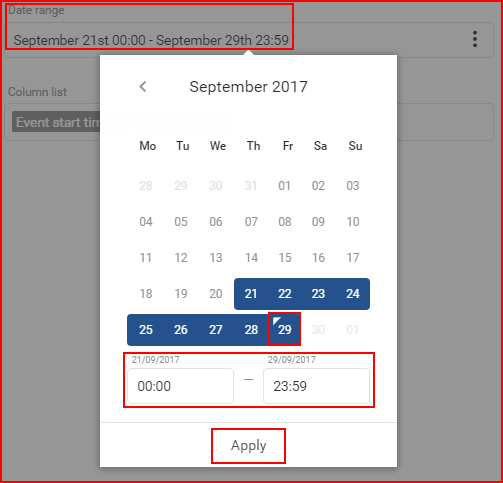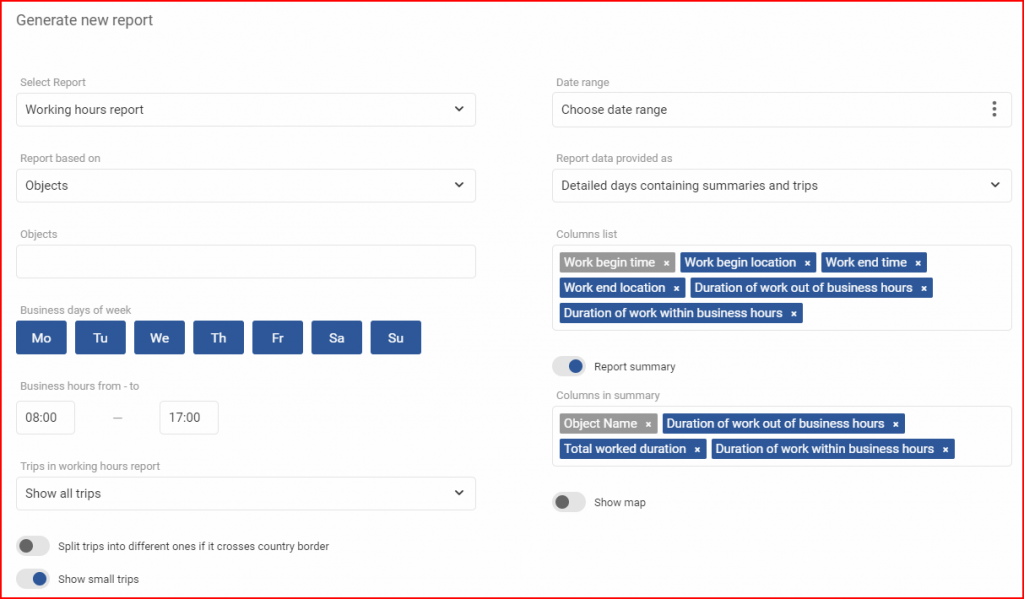Working hours report – is mainly focused on generating details around working hours, and details associated with them. The first thing the user must select is the date range, for which this report will be generated.
Date range – to select a date the user must click the “Choose date range” which will open the calendar panel. The calendar panel is identical in all of the FMS. To select a begin/end date the user must simply click the desired date and then click the opposite date. The selected days will be highlighted in blue. The current day is highlighted by a small blue triangle on the top left side of that day. If the current day is selected (highlighted), the triangle will be inverted to white. To select a preferred date start by clicking on the end or beginning date (there is no priority in choosing) and afterwards click the opposite (end/begin) date. Afterwards, the user can specify from which hour of the begin date until which hour of the end date to display the history. To apply the changes the “Apply” button must be clicked, otherwise, the changes will not be saved.

The minimal date period is one day. To select one day simply double click the left mouse button on the desired day to select it.
The maximal date period for less than 10 objects is three months (90 days). Selecting more than 10 objects will limit this to 1 month. You cannot select a longer period.
Report based on – this setting defines the main target of the report. There are two available options:
- Drivers
- Objects
What exactly this does is, that the generated report will display information (parameters: trip distance, work begin location, etc.) for the selected target (Drivers or Objects). So if Objects are selected, then the report will display information for specifically selected objects.
Report data provided as – this setting determines, how the data will be displayed. The following options are available:
- Detailed days containing summaries and trips – will display detailed working hour data for each day
- Detailed trips – will display detailed working hour data
- Summarized days – will display a summary of working hours for each day
Objects/Drivers – (Depends on the selection in the “Report based on” option) this allows the user to choose for which objects/drivers the report will be generated.
If Objects are selected, the list will also contain groups of objects. The user can select a whole group by marking the checkbox before the group or click the + button to expand the group and see which objects are in the group. To collapse the group, the user must click the – button. Individual objects can be selected from a group. It is important to note, if an object that is present in several groups is selected, it will be highlighted in every group as shown below in the picture. If a whole group is selected, the checkbox will be blue with a white tick. If only a part of the group is selected, the group will have a blue square in the checkbox. (shown in the picture below). The user can also use the search, to quickly go through a large list of objects and groups. All groups can be selected/deselected by ticking the checkbox next to “Select all groups”. The number of selected objects and total objects is displayed at the upper right corner of the list.

If Drivers is selected, drivers will be displayed in the drop-down list. To select a driver, the user has to mark the checkbox next to the driver. Marking the checkbox next to “Select all” will select/deselect all drivers. The list is automatically updated with each symbol typed in the search bar. The number of selected drivers and total drivers is displayed at the upper right corner of the list.

After objects/drivers are selected, the user must select parameters in the Column list. Only 10 columns can be selected at a time. This report will include the following columns by default:
- Work begin time – the date and time of the first ignition on event, cannot be unselected
- Work begin location – the location where the first ignition on event was triggered
- Work end time – the time of the last ignition off event
- Work end location – the location where the last ignition off event was triggered
- Duration of work out of business hours – the time duration while ignition was on during non-business hours (set by the user after the column list)
- Duration of work within business hours – the time duration while ignition was on during business hours (set by the user after the column list)
Other optional columns that can be selected:
- Driven out of business hours – the sum of total driven distance during non-business hours (set by the user after the column list)
- Driven within business hours – the sum of total driven distance during business hours (set by the user after the column list)
- End mileage – the mileage at the end of the trip (last ignition off event)
- Fuel consumed – the fuel consumed during the trip
- Idling duration – the duration of the vehicle in an idling state
- Start mileage – the mileage the beginning of the trip (first ignition on event)
- Total driven distance – the total driven distance from the beginning of the trip until the end (from ignition on event to ignition off event)
- Total worked duration – the total duration from the beginning of the trip until the end (from ignition on event to ignition off event)
- Virtual odometer – the virtual odometer mileage of trip, calculated from the difference from the trip beginning and trip end
After selecting the parameters in the columns list, the user must define the business days and hours. By default business days and hours are from 8 am to 5 pm, every day of the week. Business days (blue) are set by clicking on the days of the week, clicking on a day will set it as a non-business day (light gray). Clicking on a non-business day again will set it as a business day. Business hours are set by entering them (hours and minutes) in the provided fields. The hour range is limited from 0 to 24, the minute range is limited from 0 to 60 and the “from” time cannot be later than the “to” time.

The selected time period will be calculated as business hours, while everything else will be counted as non-business hours (for example: business hours are set from 8 to 17 Monday to Friday, so non-business hours will be set from 0 to 8 and from 17 to 24 Monday to Friday and all day on Saturday and Sunday).
After defining the business hours, the user can select what trips to show in the report:
- Show only trips out of business hours
- Show only trips within business hours
- Show all trips
Then, the user can enable or disable the following additional options:
Report summary – disabled by default, this option will include a summary section in the report. This will summarize all information in the report. The following columns are selected by default:
- Object Name – cannot be unselected
- Duration of work out of business hours
- Total worked duration
- Duration of work within business hours
Other optional columns can be selected:
- Business trip mileage
- Country ended in
- Country started in
- Driven out of business hours
- Driven within business hours
- Fuel consumed
- Private trip mileage
- Total driven distance
- Work trip mileage
Show map – disabled by default, this option will include a map in the report, with all drain/refuel events marked on it.
Split trip into different ones if it crosses country border – disabled by default, if enabled, a trip passing through a country border will be split at the point of crossing a border, thus separating it into two trips, one before the border and one after.
Show small trips – enabled by default, if enabled will include trips in the report that are shorter than 50 meters of total travel distance.

To finalize and generate the report, the user must click the Generate button. To cancel the creation of a report the user must click the Cancel button.
